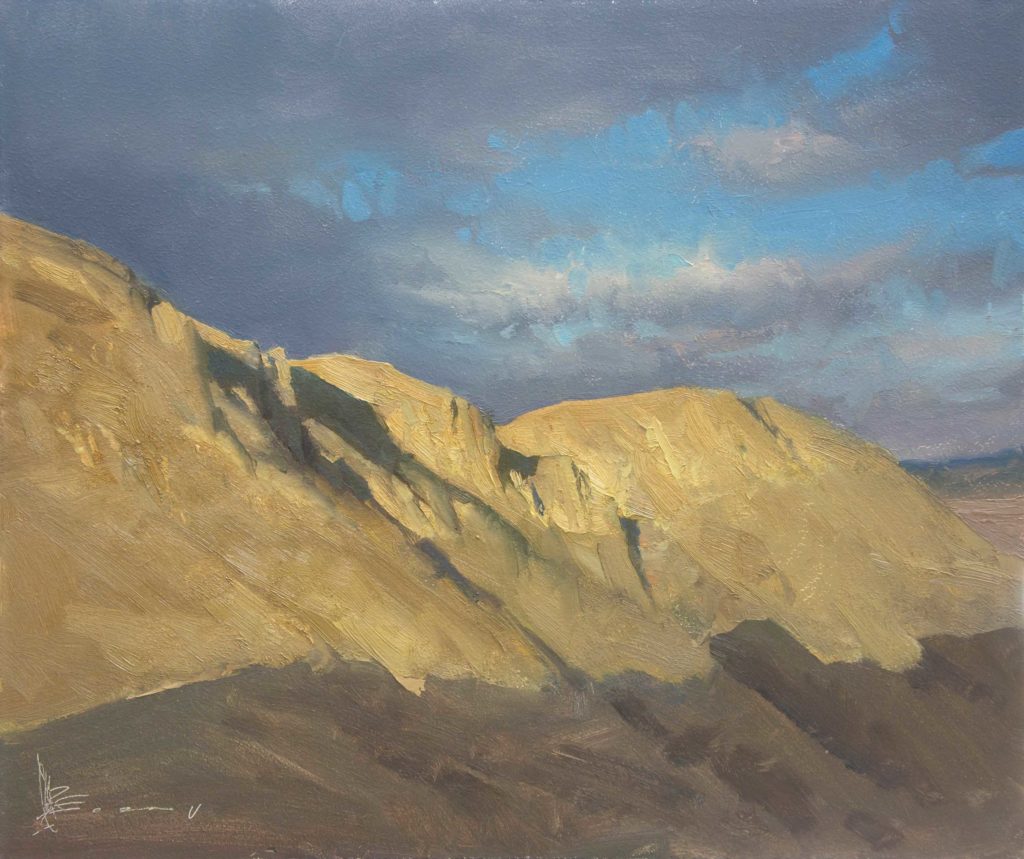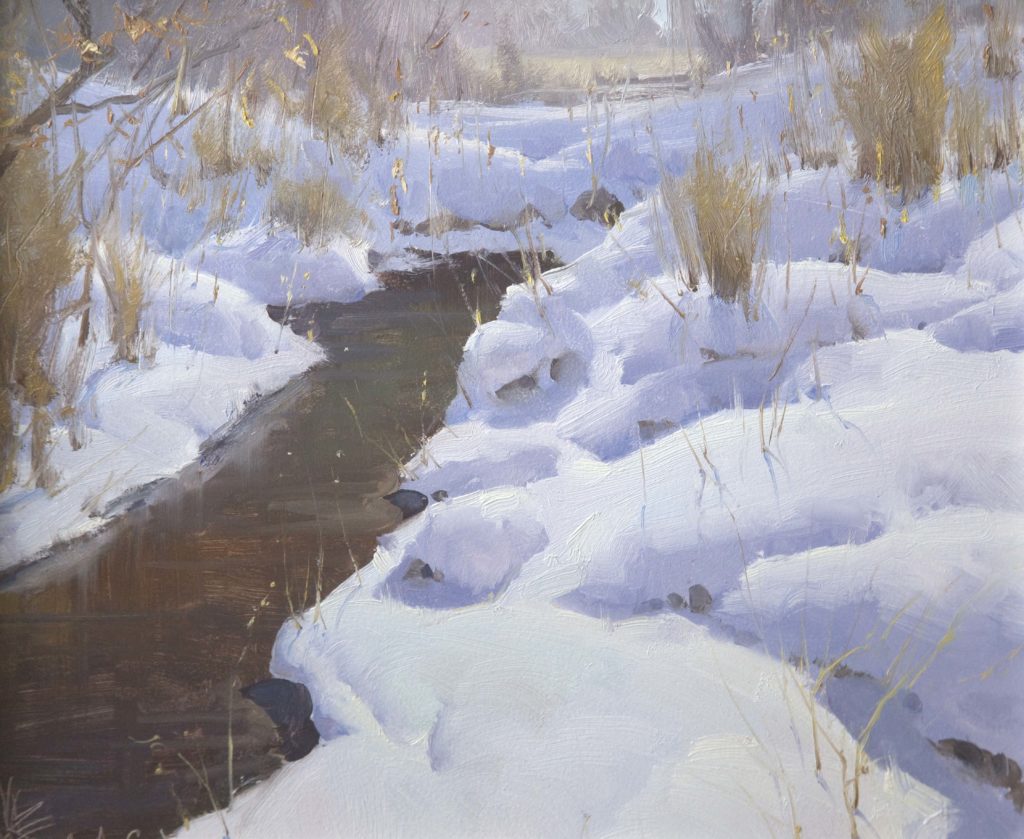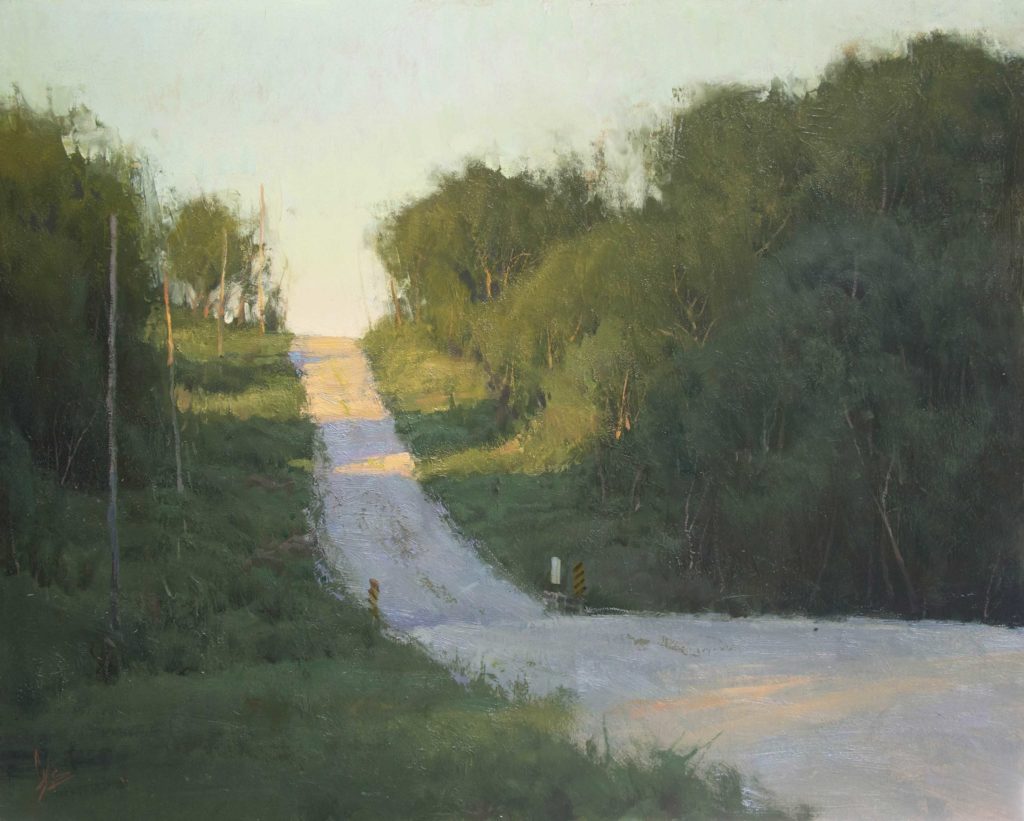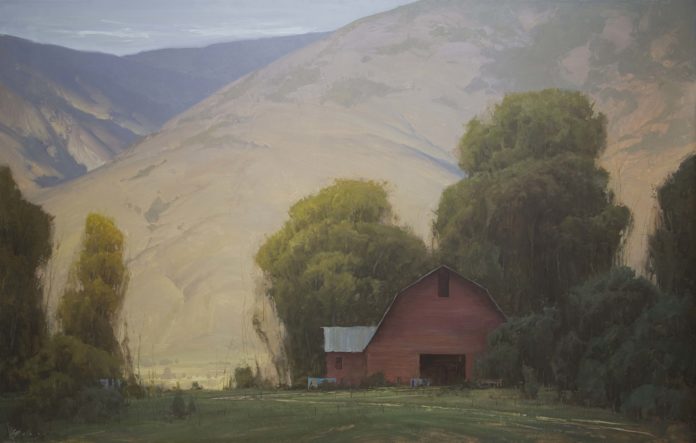On Painting Composition > Most of us mistakenly feel when we start out, that the more detail we include in a painting the more convincing it will be…
Telling the Truth – By Leaving Stuff Out
BY JOSH CLARE
Years ago Harvey Dunn—a farmer-turned-illustrator from South Dakota (look him up)—received a commission to paint some pictures of India. Dunn studied art with Howard Pyle in 1904, so this was before Google image searches. In fact it was so pre-everything-we’re-used-to that he couldn’t find a single picture of India. Listen to his story as recorded in some 1934 class notes from the Grand Central School of Art entitled “An Evening in the Classroom”:
“This picture reminds me of the time when I was asked to do some pictures of India. At that time I couldn’t find pictures of India, hunt as I might, high and low. (Just afterwards of course, the National Geographical came out with a whole magazine of colored photographs!) And they wanted them in a hurry.
“So I got busy and painted India—the way I felt of her. Tried to get the feeling into them that I had when I heard the name. There are certain feelings common to all of us, and there’s a certain glamour, a sort of halo of romance and association which is attached to names, each of us reacting in his own individual way, picturing his own version of the place, but all of us more or less sharing the same emotion.
“For instance, take the word home. In people all over the world that word will arouse a different mental picture but all will react emotionally the same. That feeling was what I was trying to get into my pictures of India, the mystery of smells, sounds and sights that we think of as India.
“There was no other way to do these pictures for I had almost no facts to go by. After they were published I had several letters from people who had lived there, asking when I’d been there. One man even went so far as to compliment me on my correctness of detail. He said that I had nicely distinguished between the turbans worn by the Mohammedan and the Hindu.”
There were no details in the pictures. Couldn’t be, because I didn’t know them. But these men built the details in themselves, and they approved of them very much—as anyone will who builds anything!
Though there’s a lot to learn from this simple story I want to focus on the seeming contradiction—that it was the absence of detail in Dunn’s illustrations that made them so remarkably truthful; that he got more into those paintings by leaving stuff out than he ever could have achieved with tedious detail.

Painting Composition Advice: Leave Stuff Out
Most of us mistakenly feel when we start out, that the more detail we include in a painting composition the more convincing it will be. Where does this lie come from? It may sound silly, but I think it’s partially the fault of the camera. We swim daily in an ocean of photographs, an alternate reality in which everything is in focus.
Humans just don’t see things that way. Our ability to perceive detail decreases by 90 percent only 20 degrees away from our center of focus. Look up from this article right now and try it! We can only focus visually on one object at a time, the rest fades quietly into the background. Seeing things simply is what we do. Less is more.
When we begin to edit rather than elaborate, and remove rather than render, we’re on our way to the kind of poetic paintings that reach right to the heart of truth. Paintings that are as superior to mere renderings as Shakespeare to a bloated copyright agreement, or Mozart to Hannah Montana.
Which leads me to what I believe is the best reason for leaving stuff out: it engages the viewer. When an artist does us the favor of leaving things out, we get to finish the painting ourselves—that’s the beauty of paintings in which details are suggested rather than supplied! The experience we have when engaging with a painting this way is more than just connecting the dots; it is a creative act akin to painting itself, and “when men build the details in themselves,” as Dunn says, “they approve of them very much.”

How to Leave Stuff Out of Your Painting Composition
1. Decide what you want to say, and say it. How are we to know what to leave out? How do we distinguish between what’s essential and what’s not? Simply by asking ourselves the crazy-important questions: why do I want to paint this? and, what am I trying to say? The answer to those questions can and should inform every decision we make in painting; leading us to know exactly what to put in and what to take out.
2. Find ways to imply detail without actually adding it. It’s not for the love of vague paintings that I’ve gone off on this—but in praise of those painters who have discovered ways to say, “look, a billion leaves,” without painting a billion leaves. The poetry of a gestural mark that our brains perceive as minute detail is what I’m so in love with!
Take a look at your favorite paintings and you’ll find a wide range of different solutions for the same problem—of how to make simple, painterly marks feel like careful rendering. It can be done with heavy impasto, or ultra-thin washes. It can be accomplished with texture, with scumbling, or glazing, or dry-brushing, or scraping, the possibilities are endless.
A note of caution: be careful not to merely borrow a single artist’s ideas and be done with it, or you’ll end up being just a watered-down version of them—not true to yourself and of little use to anyone with discriminating taste. The world needs you to be you! You’ve got to believe that. You’re unlike any other person on earth. You’ve got something to offer that nobody else can, you see the world in a way that is as unique as your fingerprints.
The choices you make of what to paint and why to paint it, of what to leave out and what to put in, and how to do it—if you make those choices yourself—will make your paintings unlike anything else on earth. Don’t deny the world that gift only to contentedly ride somebody’s coattails and never rise above dexterous mediocrity. As Constable said, “The world is full enough of what has already been done.”
How then do you discover your own shorthand for nature’s endless variety? By going directly to the source. Want to figure out how you handle trees? Shut your art books, turn off your phone, put away your camera, and go paint a thousand trees. Somewhere along the way you’ll happen upon something that works, stumble upon it even, but happy accident or not it will be the genesis of new ideas and new solutions.
You don’t have to reinvent the wheel. To disregard all of the massively beautiful things that have been done by masters past and present would be idiotic. Sometimes what we call a new idea is really just an unexpected combination of two or three old ideas.
Since we started with the great Harvey Dunn, it seems appropriate that we should give him the final word on this. Consider these two beauties:
“A little detail in the proper place will fill it with detail, but to fill it with the detail often makes the picture static.”
“The only thing that’s true about anything is the spirit of it! And if we get that and miss a lot of other things, we’ll be telling more of the truth about it than if we got all the facts and not the spirit.”

Learn more about Josh at: www.joshclare.com
Check out the following amazing opportunities for learning with Streamline Publishing:
- April 15-17, 2021: 2nd Annual Plein Air Live virtual conference
- January 27-29, 2022: 2nd Annual Watercolor Live virtual conference
Book Your Early Bird Discount before 11:59pm PT on August 31 and Save Up to $600 Off the Full Rate
> Click here to subscribe to the free newsletter, Plein Air Today
> And click here to subscribe to PleinAir Magazine so you never miss an issue!




